Public Health: Analysis of Australia's Healthcare Workforce Shortage
VerifiedAdded on 2019/11/20
|16
|3009
|252
Report
AI Summary
This report analyzes Australia's reliance on global health provider migration to address its healthcare workforce shortages. It examines Australian health policies, the reasons for their development, and the "pull" factors they create, along with the "push" factors from countries like India that contribute to this migration. The report explores the impact of these policies on global health and the ethical implications of workforce imbalances. It also discusses the need for changes in health workforce management by both Australian and international governments to reduce migration and achieve the 2030 WHO targets. The report highlights the imbalance between urban and rural healthcare provisions and the impact of the dual system of healthcare in Australia. The study also covers the impact of brain drain and suggests the need for coordinated global responses and national policies to address these challenges effectively.
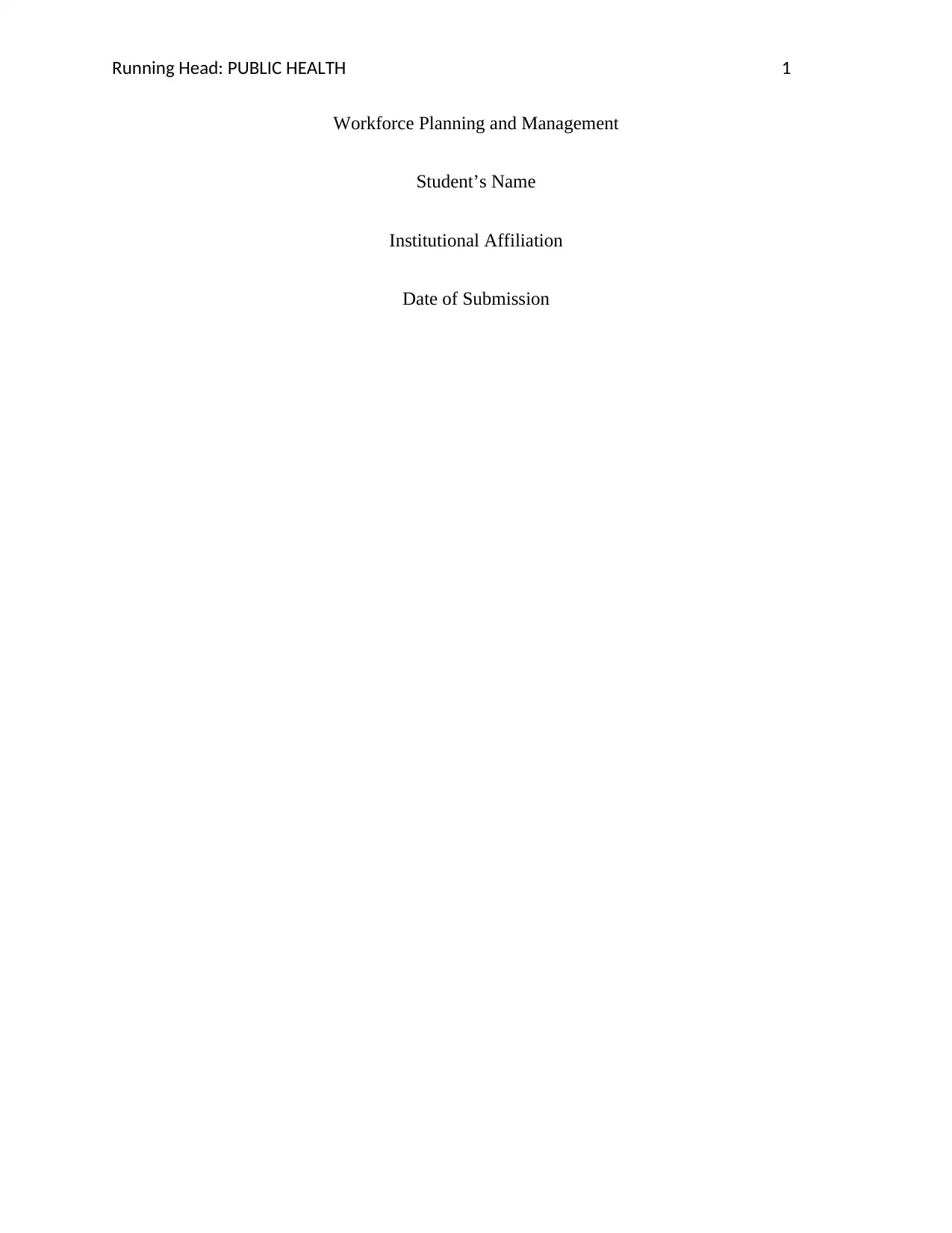
Running Head: PUBLIC HEALTH 1
Workforce Planning and Management
Student’s Name
Institutional Affiliation
Date of Submission
Workforce Planning and Management
Student’s Name
Institutional Affiliation
Date of Submission
Paraphrase This Document
Need a fresh take? Get an instant paraphrase of this document with our AI Paraphraser
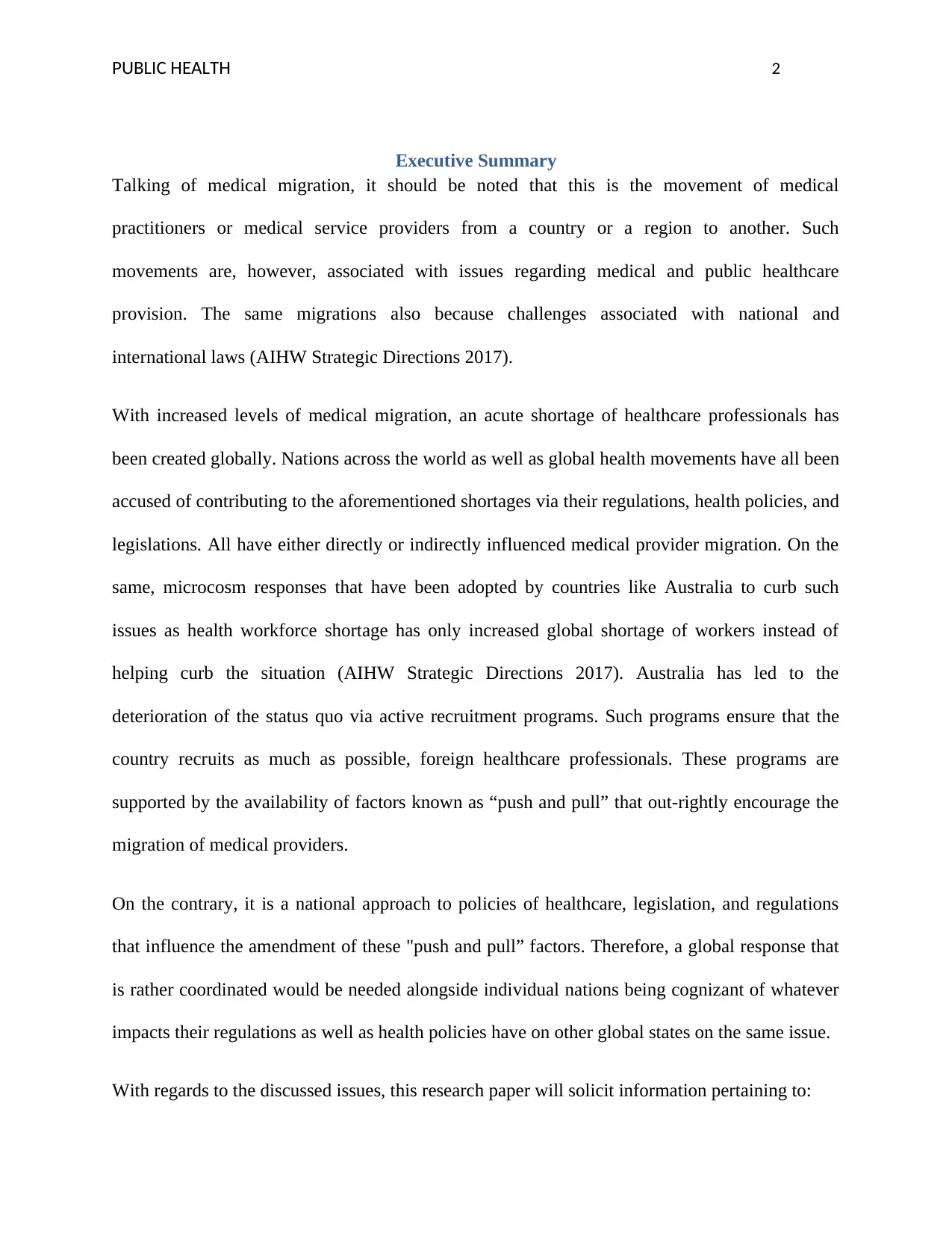
PUBLIC HEALTH 2
Executive Summary
Talking of medical migration, it should be noted that this is the movement of medical
practitioners or medical service providers from a country or a region to another. Such
movements are, however, associated with issues regarding medical and public healthcare
provision. The same migrations also because challenges associated with national and
international laws (AIHW Strategic Directions 2017).
With increased levels of medical migration, an acute shortage of healthcare professionals has
been created globally. Nations across the world as well as global health movements have all been
accused of contributing to the aforementioned shortages via their regulations, health policies, and
legislations. All have either directly or indirectly influenced medical provider migration. On the
same, microcosm responses that have been adopted by countries like Australia to curb such
issues as health workforce shortage has only increased global shortage of workers instead of
helping curb the situation (AIHW Strategic Directions 2017). Australia has led to the
deterioration of the status quo via active recruitment programs. Such programs ensure that the
country recruits as much as possible, foreign healthcare professionals. These programs are
supported by the availability of factors known as “push and pull” that out-rightly encourage the
migration of medical providers.
On the contrary, it is a national approach to policies of healthcare, legislation, and regulations
that influence the amendment of these "push and pull” factors. Therefore, a global response that
is rather coordinated would be needed alongside individual nations being cognizant of whatever
impacts their regulations as well as health policies have on other global states on the same issue.
With regards to the discussed issues, this research paper will solicit information pertaining to:
Executive Summary
Talking of medical migration, it should be noted that this is the movement of medical
practitioners or medical service providers from a country or a region to another. Such
movements are, however, associated with issues regarding medical and public healthcare
provision. The same migrations also because challenges associated with national and
international laws (AIHW Strategic Directions 2017).
With increased levels of medical migration, an acute shortage of healthcare professionals has
been created globally. Nations across the world as well as global health movements have all been
accused of contributing to the aforementioned shortages via their regulations, health policies, and
legislations. All have either directly or indirectly influenced medical provider migration. On the
same, microcosm responses that have been adopted by countries like Australia to curb such
issues as health workforce shortage has only increased global shortage of workers instead of
helping curb the situation (AIHW Strategic Directions 2017). Australia has led to the
deterioration of the status quo via active recruitment programs. Such programs ensure that the
country recruits as much as possible, foreign healthcare professionals. These programs are
supported by the availability of factors known as “push and pull” that out-rightly encourage the
migration of medical providers.
On the contrary, it is a national approach to policies of healthcare, legislation, and regulations
that influence the amendment of these "push and pull” factors. Therefore, a global response that
is rather coordinated would be needed alongside individual nations being cognizant of whatever
impacts their regulations as well as health policies have on other global states on the same issue.
With regards to the discussed issues, this research paper will solicit information pertaining to:
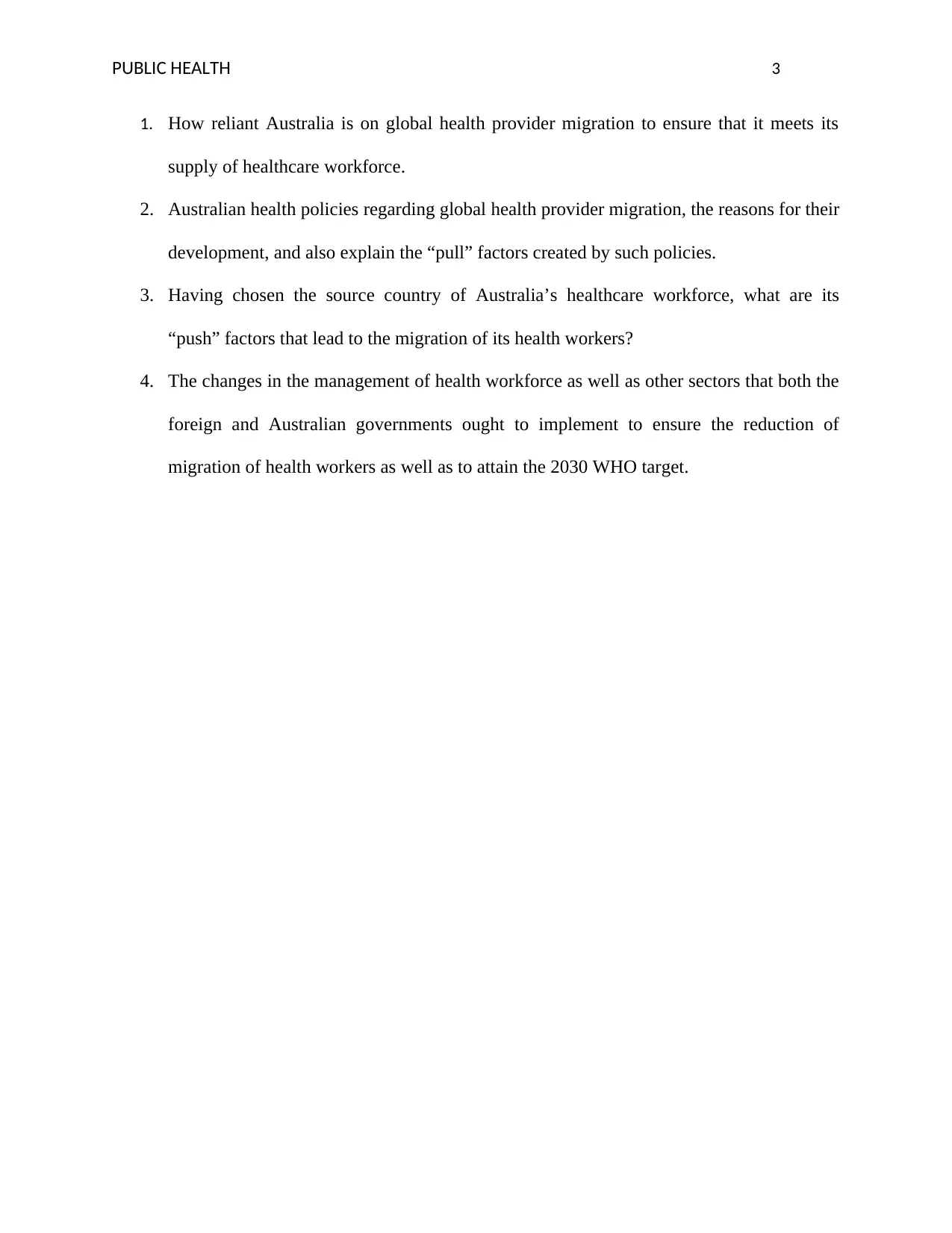
PUBLIC HEALTH 3
1. How reliant Australia is on global health provider migration to ensure that it meets its
supply of healthcare workforce.
2. Australian health policies regarding global health provider migration, the reasons for their
development, and also explain the “pull” factors created by such policies.
3. Having chosen the source country of Australia’s healthcare workforce, what are its
“push” factors that lead to the migration of its health workers?
4. The changes in the management of health workforce as well as other sectors that both the
foreign and Australian governments ought to implement to ensure the reduction of
migration of health workers as well as to attain the 2030 WHO target.
1. How reliant Australia is on global health provider migration to ensure that it meets its
supply of healthcare workforce.
2. Australian health policies regarding global health provider migration, the reasons for their
development, and also explain the “pull” factors created by such policies.
3. Having chosen the source country of Australia’s healthcare workforce, what are its
“push” factors that lead to the migration of its health workers?
4. The changes in the management of health workforce as well as other sectors that both the
foreign and Australian governments ought to implement to ensure the reduction of
migration of health workers as well as to attain the 2030 WHO target.
⊘ This is a preview!⊘
Do you want full access?
Subscribe today to unlock all pages.

Trusted by 1+ million students worldwide
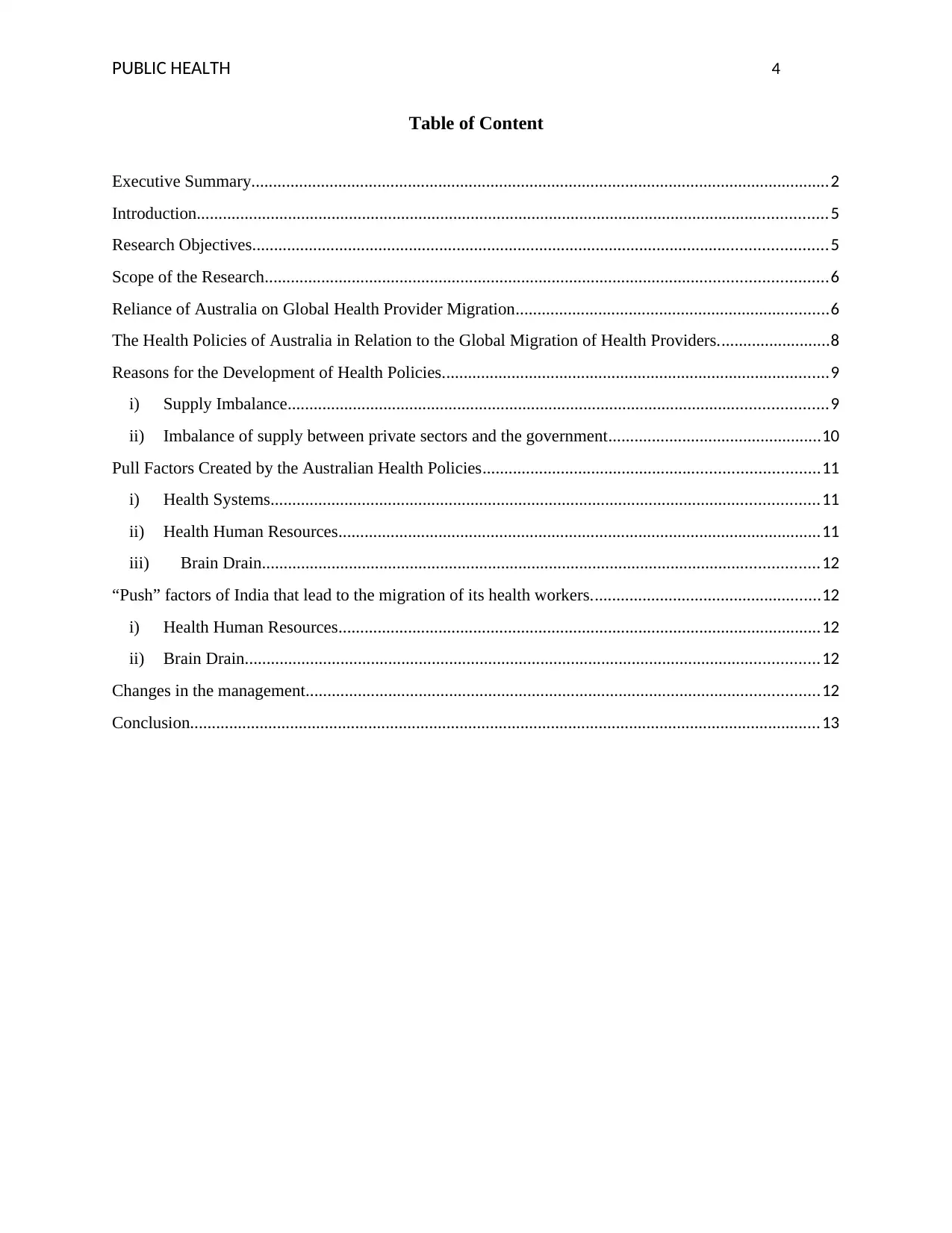
PUBLIC HEALTH 4
Table of Content
Executive Summary.....................................................................................................................................2
Introduction.................................................................................................................................................5
Research Objectives....................................................................................................................................5
Scope of the Research.................................................................................................................................6
Reliance of Australia on Global Health Provider Migration........................................................................6
The Health Policies of Australia in Relation to the Global Migration of Health Providers..........................8
Reasons for the Development of Health Policies.........................................................................................9
i) Supply Imbalance............................................................................................................................9
ii) Imbalance of supply between private sectors and the government.................................................10
Pull Factors Created by the Australian Health Policies.............................................................................11
i) Health Systems..............................................................................................................................11
ii) Health Human Resources...............................................................................................................11
iii) Brain Drain................................................................................................................................12
“Push” factors of India that lead to the migration of its health workers.....................................................12
i) Health Human Resources...............................................................................................................12
ii) Brain Drain....................................................................................................................................12
Changes in the management......................................................................................................................12
Conclusion.................................................................................................................................................13
Table of Content
Executive Summary.....................................................................................................................................2
Introduction.................................................................................................................................................5
Research Objectives....................................................................................................................................5
Scope of the Research.................................................................................................................................6
Reliance of Australia on Global Health Provider Migration........................................................................6
The Health Policies of Australia in Relation to the Global Migration of Health Providers..........................8
Reasons for the Development of Health Policies.........................................................................................9
i) Supply Imbalance............................................................................................................................9
ii) Imbalance of supply between private sectors and the government.................................................10
Pull Factors Created by the Australian Health Policies.............................................................................11
i) Health Systems..............................................................................................................................11
ii) Health Human Resources...............................................................................................................11
iii) Brain Drain................................................................................................................................12
“Push” factors of India that lead to the migration of its health workers.....................................................12
i) Health Human Resources...............................................................................................................12
ii) Brain Drain....................................................................................................................................12
Changes in the management......................................................................................................................12
Conclusion.................................................................................................................................................13
Paraphrase This Document
Need a fresh take? Get an instant paraphrase of this document with our AI Paraphraser
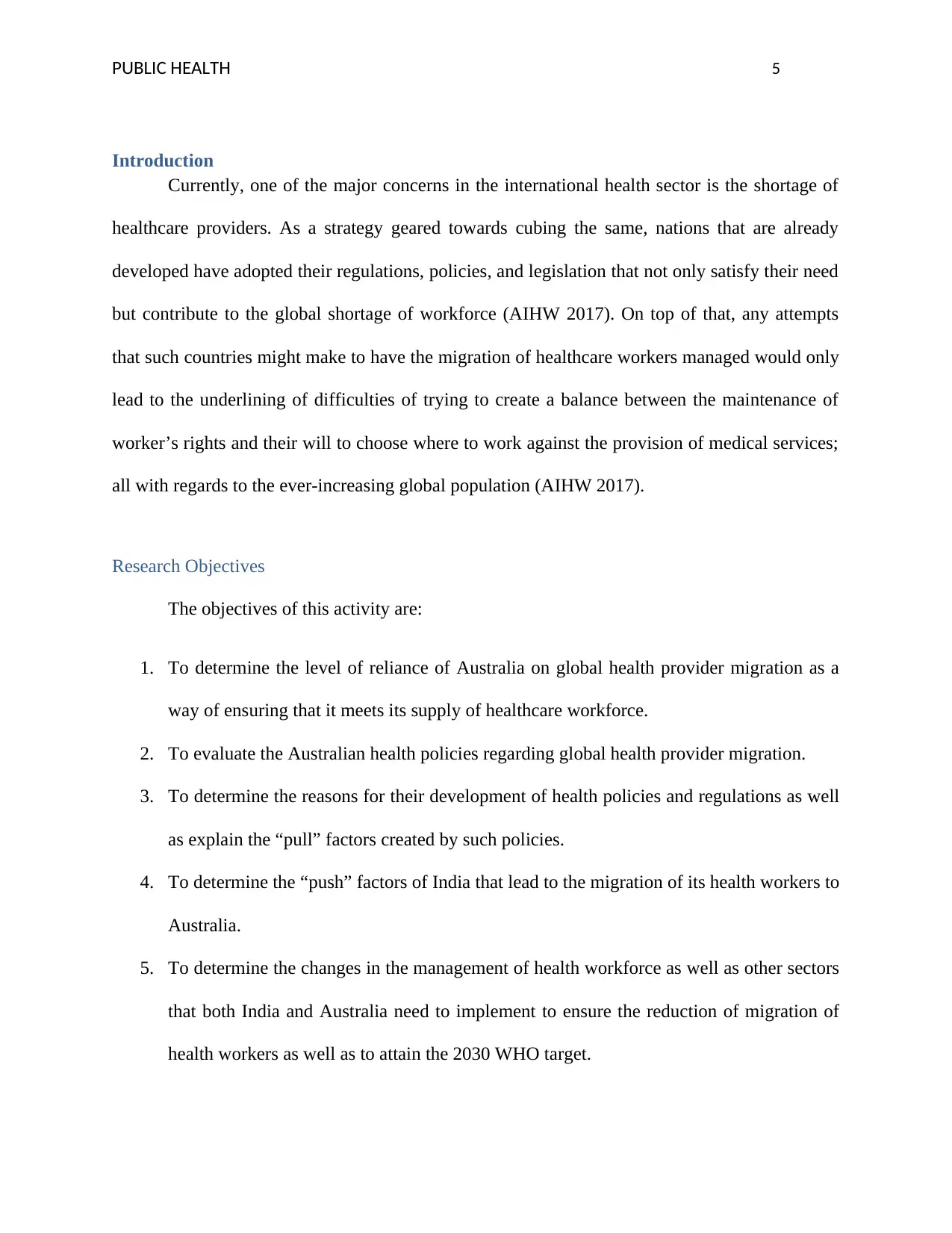
PUBLIC HEALTH 5
Introduction
Currently, one of the major concerns in the international health sector is the shortage of
healthcare providers. As a strategy geared towards cubing the same, nations that are already
developed have adopted their regulations, policies, and legislation that not only satisfy their need
but contribute to the global shortage of workforce (AIHW 2017). On top of that, any attempts
that such countries might make to have the migration of healthcare workers managed would only
lead to the underlining of difficulties of trying to create a balance between the maintenance of
worker’s rights and their will to choose where to work against the provision of medical services;
all with regards to the ever-increasing global population (AIHW 2017).
Research Objectives
The objectives of this activity are:
1. To determine the level of reliance of Australia on global health provider migration as a
way of ensuring that it meets its supply of healthcare workforce.
2. To evaluate the Australian health policies regarding global health provider migration.
3. To determine the reasons for their development of health policies and regulations as well
as explain the “pull” factors created by such policies.
4. To determine the “push” factors of India that lead to the migration of its health workers to
Australia.
5. To determine the changes in the management of health workforce as well as other sectors
that both India and Australia need to implement to ensure the reduction of migration of
health workers as well as to attain the 2030 WHO target.
Introduction
Currently, one of the major concerns in the international health sector is the shortage of
healthcare providers. As a strategy geared towards cubing the same, nations that are already
developed have adopted their regulations, policies, and legislation that not only satisfy their need
but contribute to the global shortage of workforce (AIHW 2017). On top of that, any attempts
that such countries might make to have the migration of healthcare workers managed would only
lead to the underlining of difficulties of trying to create a balance between the maintenance of
worker’s rights and their will to choose where to work against the provision of medical services;
all with regards to the ever-increasing global population (AIHW 2017).
Research Objectives
The objectives of this activity are:
1. To determine the level of reliance of Australia on global health provider migration as a
way of ensuring that it meets its supply of healthcare workforce.
2. To evaluate the Australian health policies regarding global health provider migration.
3. To determine the reasons for their development of health policies and regulations as well
as explain the “pull” factors created by such policies.
4. To determine the “push” factors of India that lead to the migration of its health workers to
Australia.
5. To determine the changes in the management of health workforce as well as other sectors
that both India and Australia need to implement to ensure the reduction of migration of
health workers as well as to attain the 2030 WHO target.
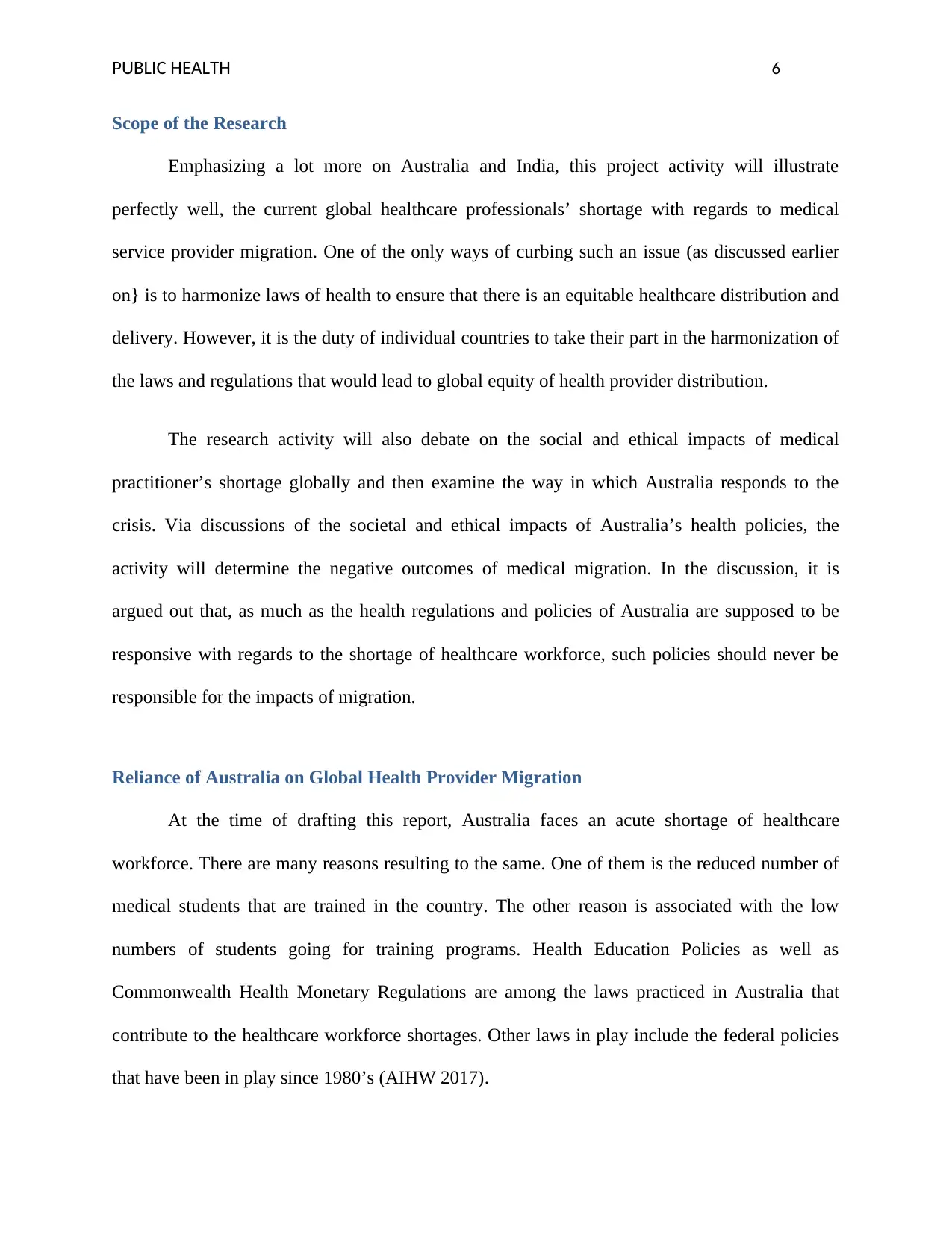
PUBLIC HEALTH 6
Scope of the Research
Emphasizing a lot more on Australia and India, this project activity will illustrate
perfectly well, the current global healthcare professionals’ shortage with regards to medical
service provider migration. One of the only ways of curbing such an issue (as discussed earlier
on} is to harmonize laws of health to ensure that there is an equitable healthcare distribution and
delivery. However, it is the duty of individual countries to take their part in the harmonization of
the laws and regulations that would lead to global equity of health provider distribution.
The research activity will also debate on the social and ethical impacts of medical
practitioner’s shortage globally and then examine the way in which Australia responds to the
crisis. Via discussions of the societal and ethical impacts of Australia’s health policies, the
activity will determine the negative outcomes of medical migration. In the discussion, it is
argued out that, as much as the health regulations and policies of Australia are supposed to be
responsive with regards to the shortage of healthcare workforce, such policies should never be
responsible for the impacts of migration.
Reliance of Australia on Global Health Provider Migration
At the time of drafting this report, Australia faces an acute shortage of healthcare
workforce. There are many reasons resulting to the same. One of them is the reduced number of
medical students that are trained in the country. The other reason is associated with the low
numbers of students going for training programs. Health Education Policies as well as
Commonwealth Health Monetary Regulations are among the laws practiced in Australia that
contribute to the healthcare workforce shortages. Other laws in play include the federal policies
that have been in play since 1980’s (AIHW 2017).
Scope of the Research
Emphasizing a lot more on Australia and India, this project activity will illustrate
perfectly well, the current global healthcare professionals’ shortage with regards to medical
service provider migration. One of the only ways of curbing such an issue (as discussed earlier
on} is to harmonize laws of health to ensure that there is an equitable healthcare distribution and
delivery. However, it is the duty of individual countries to take their part in the harmonization of
the laws and regulations that would lead to global equity of health provider distribution.
The research activity will also debate on the social and ethical impacts of medical
practitioner’s shortage globally and then examine the way in which Australia responds to the
crisis. Via discussions of the societal and ethical impacts of Australia’s health policies, the
activity will determine the negative outcomes of medical migration. In the discussion, it is
argued out that, as much as the health regulations and policies of Australia are supposed to be
responsive with regards to the shortage of healthcare workforce, such policies should never be
responsible for the impacts of migration.
Reliance of Australia on Global Health Provider Migration
At the time of drafting this report, Australia faces an acute shortage of healthcare
workforce. There are many reasons resulting to the same. One of them is the reduced number of
medical students that are trained in the country. The other reason is associated with the low
numbers of students going for training programs. Health Education Policies as well as
Commonwealth Health Monetary Regulations are among the laws practiced in Australia that
contribute to the healthcare workforce shortages. Other laws in play include the federal policies
that have been in play since 1980’s (AIHW 2017).
⊘ This is a preview!⊘
Do you want full access?
Subscribe today to unlock all pages.

Trusted by 1+ million students worldwide
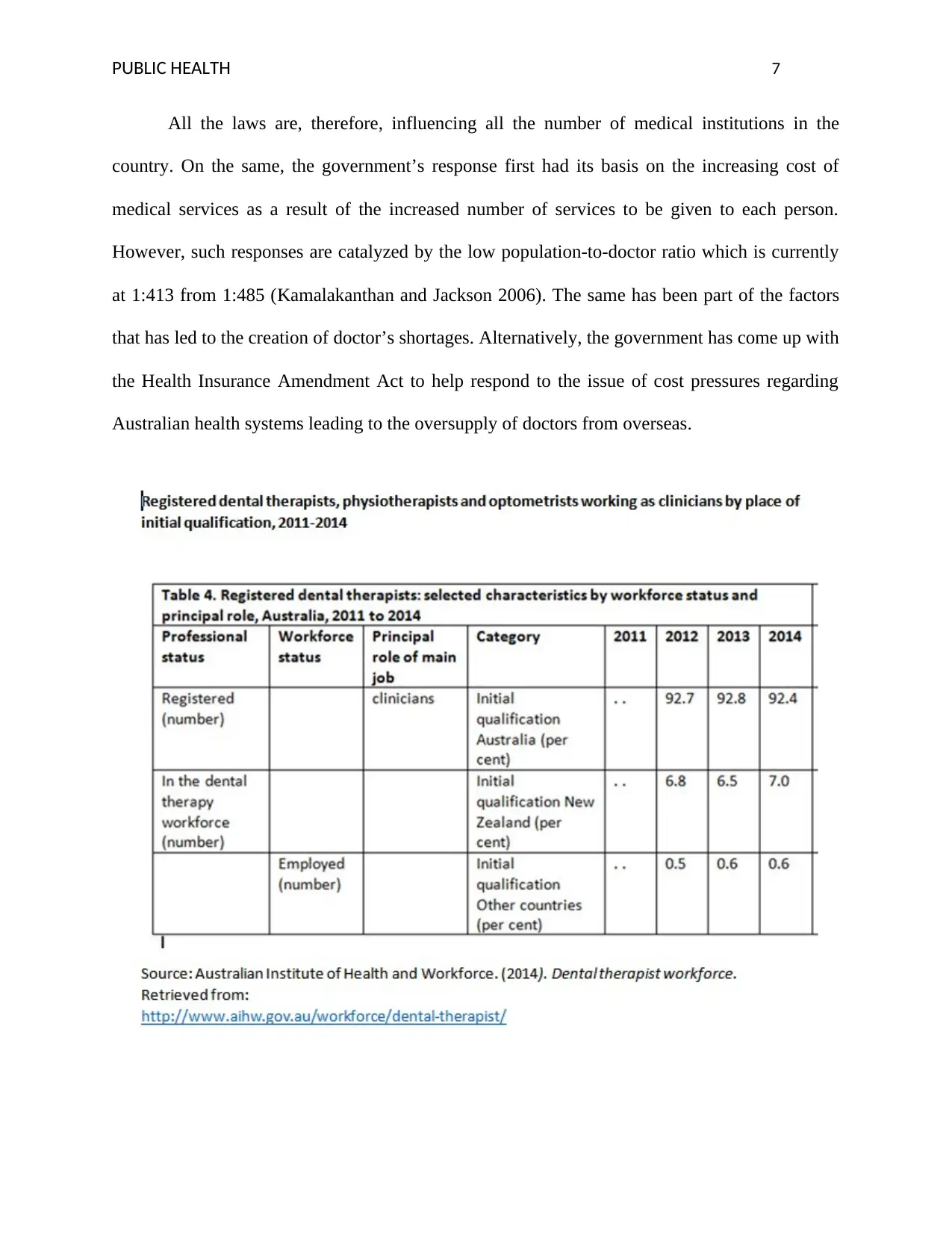
PUBLIC HEALTH 7
All the laws are, therefore, influencing all the number of medical institutions in the
country. On the same, the government’s response first had its basis on the increasing cost of
medical services as a result of the increased number of services to be given to each person.
However, such responses are catalyzed by the low population-to-doctor ratio which is currently
at 1:413 from 1:485 (Kamalakanthan and Jackson 2006). The same has been part of the factors
that has led to the creation of doctor’s shortages. Alternatively, the government has come up with
the Health Insurance Amendment Act to help respond to the issue of cost pressures regarding
Australian health systems leading to the oversupply of doctors from overseas.
All the laws are, therefore, influencing all the number of medical institutions in the
country. On the same, the government’s response first had its basis on the increasing cost of
medical services as a result of the increased number of services to be given to each person.
However, such responses are catalyzed by the low population-to-doctor ratio which is currently
at 1:413 from 1:485 (Kamalakanthan and Jackson 2006). The same has been part of the factors
that has led to the creation of doctor’s shortages. Alternatively, the government has come up with
the Health Insurance Amendment Act to help respond to the issue of cost pressures regarding
Australian health systems leading to the oversupply of doctors from overseas.
Paraphrase This Document
Need a fresh take? Get an instant paraphrase of this document with our AI Paraphraser
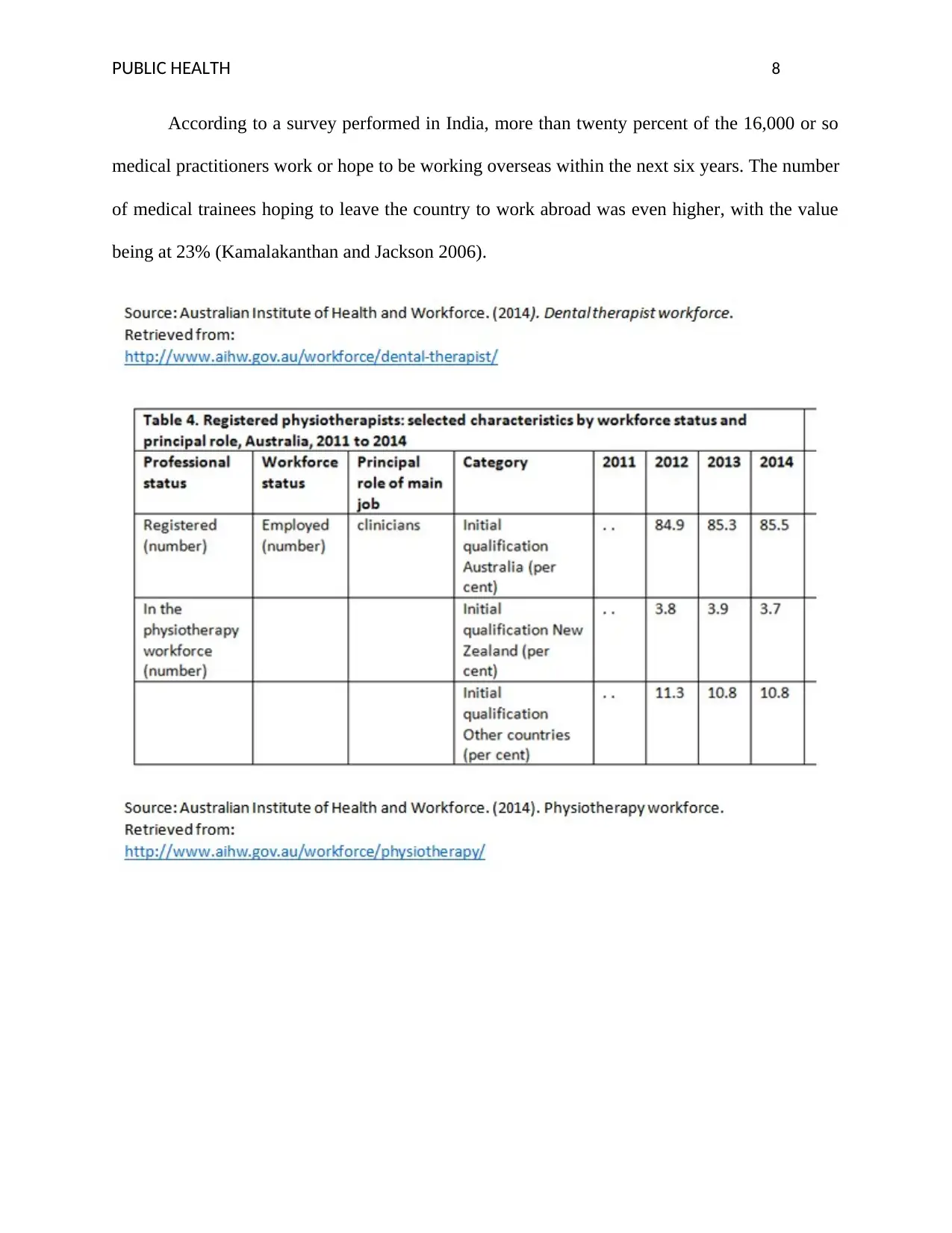
PUBLIC HEALTH 8
According to a survey performed in India, more than twenty percent of the 16,000 or so
medical practitioners work or hope to be working overseas within the next six years. The number
of medical trainees hoping to leave the country to work abroad was even higher, with the value
being at 23% (Kamalakanthan and Jackson 2006).
According to a survey performed in India, more than twenty percent of the 16,000 or so
medical practitioners work or hope to be working overseas within the next six years. The number
of medical trainees hoping to leave the country to work abroad was even higher, with the value
being at 23% (Kamalakanthan and Jackson 2006).
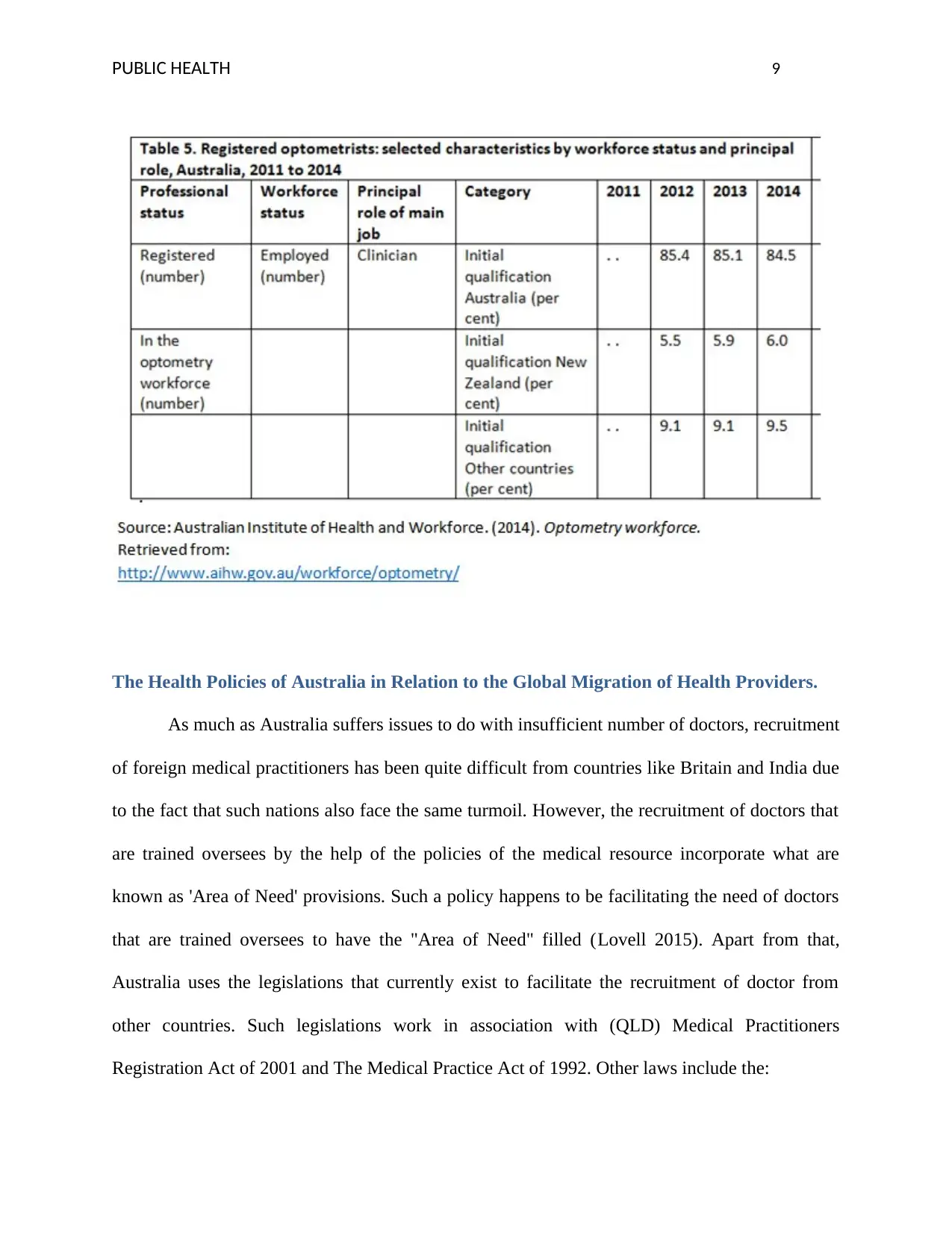
PUBLIC HEALTH 9
The Health Policies of Australia in Relation to the Global Migration of Health Providers.
As much as Australia suffers issues to do with insufficient number of doctors, recruitment
of foreign medical practitioners has been quite difficult from countries like Britain and India due
to the fact that such nations also face the same turmoil. However, the recruitment of doctors that
are trained oversees by the help of the policies of the medical resource incorporate what are
known as 'Area of Need' provisions. Such a policy happens to be facilitating the need of doctors
that are trained oversees to have the "Area of Need" filled (Lovell 2015). Apart from that,
Australia uses the legislations that currently exist to facilitate the recruitment of doctor from
other countries. Such legislations work in association with (QLD) Medical Practitioners
Registration Act of 2001 and The Medical Practice Act of 1992. Other laws include the:
The Health Policies of Australia in Relation to the Global Migration of Health Providers.
As much as Australia suffers issues to do with insufficient number of doctors, recruitment
of foreign medical practitioners has been quite difficult from countries like Britain and India due
to the fact that such nations also face the same turmoil. However, the recruitment of doctors that
are trained oversees by the help of the policies of the medical resource incorporate what are
known as 'Area of Need' provisions. Such a policy happens to be facilitating the need of doctors
that are trained oversees to have the "Area of Need" filled (Lovell 2015). Apart from that,
Australia uses the legislations that currently exist to facilitate the recruitment of doctor from
other countries. Such legislations work in association with (QLD) Medical Practitioners
Registration Act of 2001 and The Medical Practice Act of 1992. Other laws include the:
⊘ This is a preview!⊘
Do you want full access?
Subscribe today to unlock all pages.

Trusted by 1+ million students worldwide
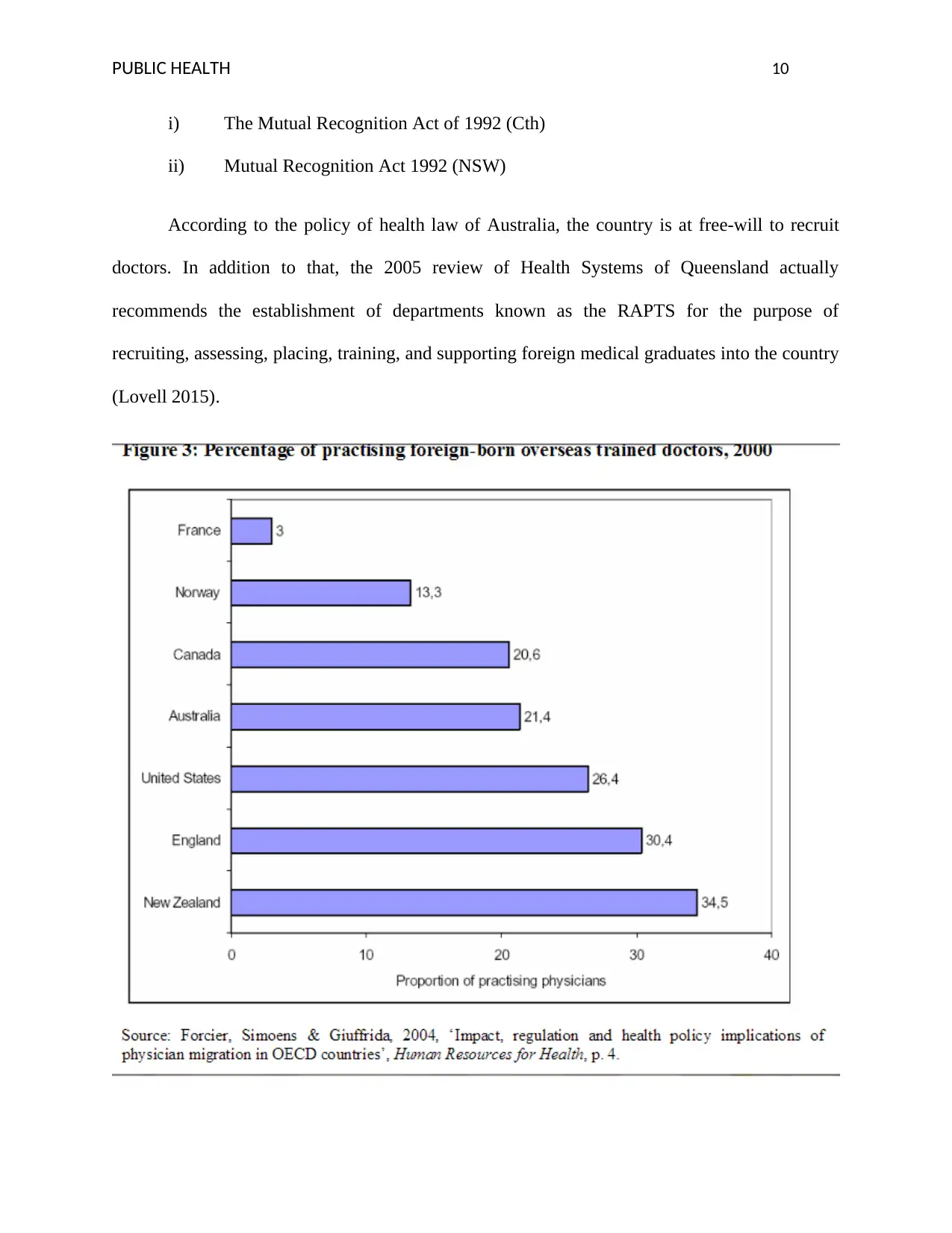
PUBLIC HEALTH 10
i) The Mutual Recognition Act of 1992 (Cth)
ii) Mutual Recognition Act 1992 (NSW)
According to the policy of health law of Australia, the country is at free-will to recruit
doctors. In addition to that, the 2005 review of Health Systems of Queensland actually
recommends the establishment of departments known as the RAPTS for the purpose of
recruiting, assessing, placing, training, and supporting foreign medical graduates into the country
(Lovell 2015).
i) The Mutual Recognition Act of 1992 (Cth)
ii) Mutual Recognition Act 1992 (NSW)
According to the policy of health law of Australia, the country is at free-will to recruit
doctors. In addition to that, the 2005 review of Health Systems of Queensland actually
recommends the establishment of departments known as the RAPTS for the purpose of
recruiting, assessing, placing, training, and supporting foreign medical graduates into the country
(Lovell 2015).
Paraphrase This Document
Need a fresh take? Get an instant paraphrase of this document with our AI Paraphraser
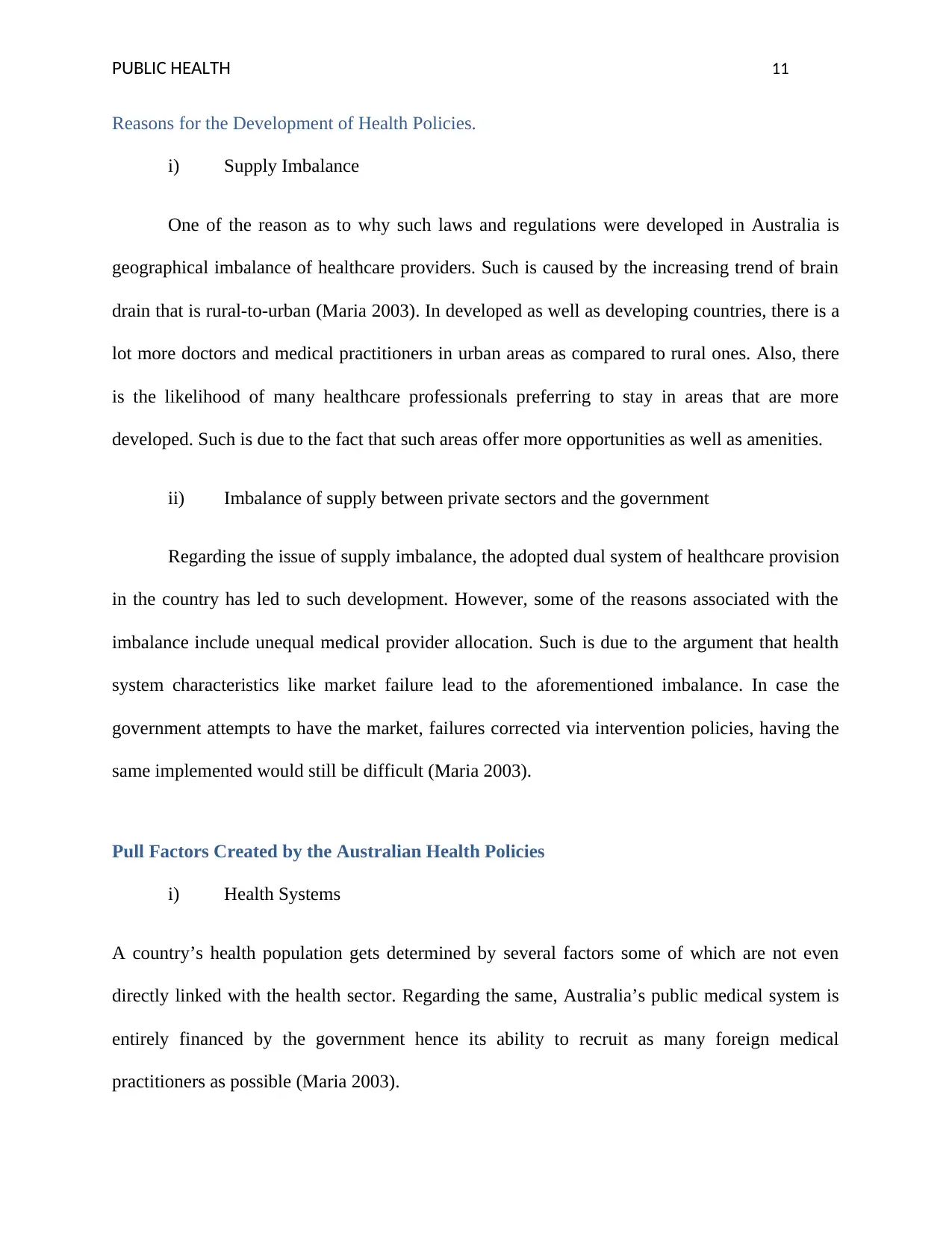
PUBLIC HEALTH 11
Reasons for the Development of Health Policies.
i) Supply Imbalance
One of the reason as to why such laws and regulations were developed in Australia is
geographical imbalance of healthcare providers. Such is caused by the increasing trend of brain
drain that is rural-to-urban (Maria 2003). In developed as well as developing countries, there is a
lot more doctors and medical practitioners in urban areas as compared to rural ones. Also, there
is the likelihood of many healthcare professionals preferring to stay in areas that are more
developed. Such is due to the fact that such areas offer more opportunities as well as amenities.
ii) Imbalance of supply between private sectors and the government
Regarding the issue of supply imbalance, the adopted dual system of healthcare provision
in the country has led to such development. However, some of the reasons associated with the
imbalance include unequal medical provider allocation. Such is due to the argument that health
system characteristics like market failure lead to the aforementioned imbalance. In case the
government attempts to have the market, failures corrected via intervention policies, having the
same implemented would still be difficult (Maria 2003).
Pull Factors Created by the Australian Health Policies
i) Health Systems
A country’s health population gets determined by several factors some of which are not even
directly linked with the health sector. Regarding the same, Australia’s public medical system is
entirely financed by the government hence its ability to recruit as many foreign medical
practitioners as possible (Maria 2003).
Reasons for the Development of Health Policies.
i) Supply Imbalance
One of the reason as to why such laws and regulations were developed in Australia is
geographical imbalance of healthcare providers. Such is caused by the increasing trend of brain
drain that is rural-to-urban (Maria 2003). In developed as well as developing countries, there is a
lot more doctors and medical practitioners in urban areas as compared to rural ones. Also, there
is the likelihood of many healthcare professionals preferring to stay in areas that are more
developed. Such is due to the fact that such areas offer more opportunities as well as amenities.
ii) Imbalance of supply between private sectors and the government
Regarding the issue of supply imbalance, the adopted dual system of healthcare provision
in the country has led to such development. However, some of the reasons associated with the
imbalance include unequal medical provider allocation. Such is due to the argument that health
system characteristics like market failure lead to the aforementioned imbalance. In case the
government attempts to have the market, failures corrected via intervention policies, having the
same implemented would still be difficult (Maria 2003).
Pull Factors Created by the Australian Health Policies
i) Health Systems
A country’s health population gets determined by several factors some of which are not even
directly linked with the health sector. Regarding the same, Australia’s public medical system is
entirely financed by the government hence its ability to recruit as many foreign medical
practitioners as possible (Maria 2003).
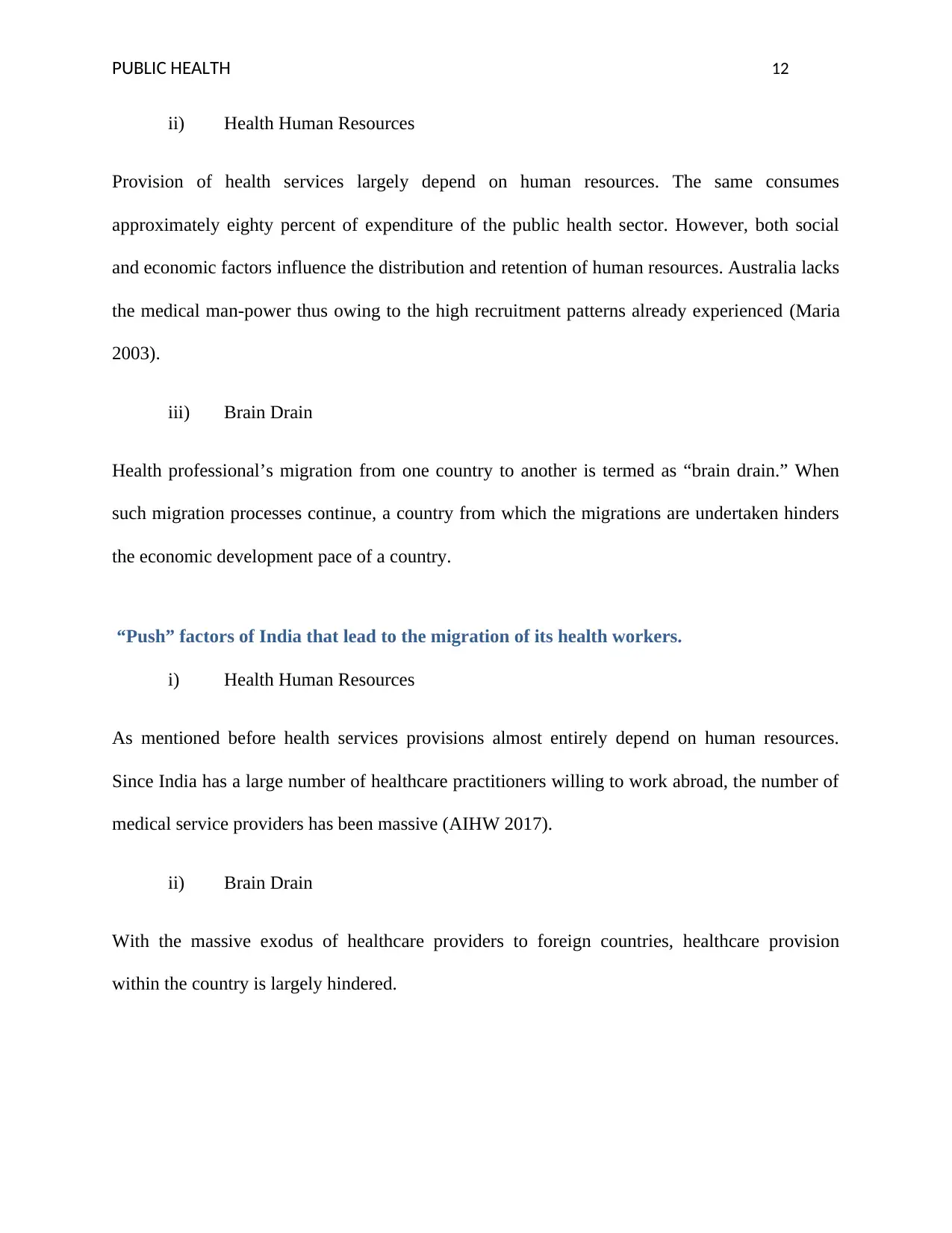
PUBLIC HEALTH 12
ii) Health Human Resources
Provision of health services largely depend on human resources. The same consumes
approximately eighty percent of expenditure of the public health sector. However, both social
and economic factors influence the distribution and retention of human resources. Australia lacks
the medical man-power thus owing to the high recruitment patterns already experienced (Maria
2003).
iii) Brain Drain
Health professional’s migration from one country to another is termed as “brain drain.” When
such migration processes continue, a country from which the migrations are undertaken hinders
the economic development pace of a country.
“Push” factors of India that lead to the migration of its health workers.
i) Health Human Resources
As mentioned before health services provisions almost entirely depend on human resources.
Since India has a large number of healthcare practitioners willing to work abroad, the number of
medical service providers has been massive (AIHW 2017).
ii) Brain Drain
With the massive exodus of healthcare providers to foreign countries, healthcare provision
within the country is largely hindered.
ii) Health Human Resources
Provision of health services largely depend on human resources. The same consumes
approximately eighty percent of expenditure of the public health sector. However, both social
and economic factors influence the distribution and retention of human resources. Australia lacks
the medical man-power thus owing to the high recruitment patterns already experienced (Maria
2003).
iii) Brain Drain
Health professional’s migration from one country to another is termed as “brain drain.” When
such migration processes continue, a country from which the migrations are undertaken hinders
the economic development pace of a country.
“Push” factors of India that lead to the migration of its health workers.
i) Health Human Resources
As mentioned before health services provisions almost entirely depend on human resources.
Since India has a large number of healthcare practitioners willing to work abroad, the number of
medical service providers has been massive (AIHW 2017).
ii) Brain Drain
With the massive exodus of healthcare providers to foreign countries, healthcare provision
within the country is largely hindered.
⊘ This is a preview!⊘
Do you want full access?
Subscribe today to unlock all pages.

Trusted by 1+ million students worldwide
1 out of 16
Related Documents
Your All-in-One AI-Powered Toolkit for Academic Success.
+13062052269
info@desklib.com
Available 24*7 on WhatsApp / Email
![[object Object]](/_next/static/media/star-bottom.7253800d.svg)
Unlock your academic potential
Copyright © 2020–2025 A2Z Services. All Rights Reserved. Developed and managed by ZUCOL.





